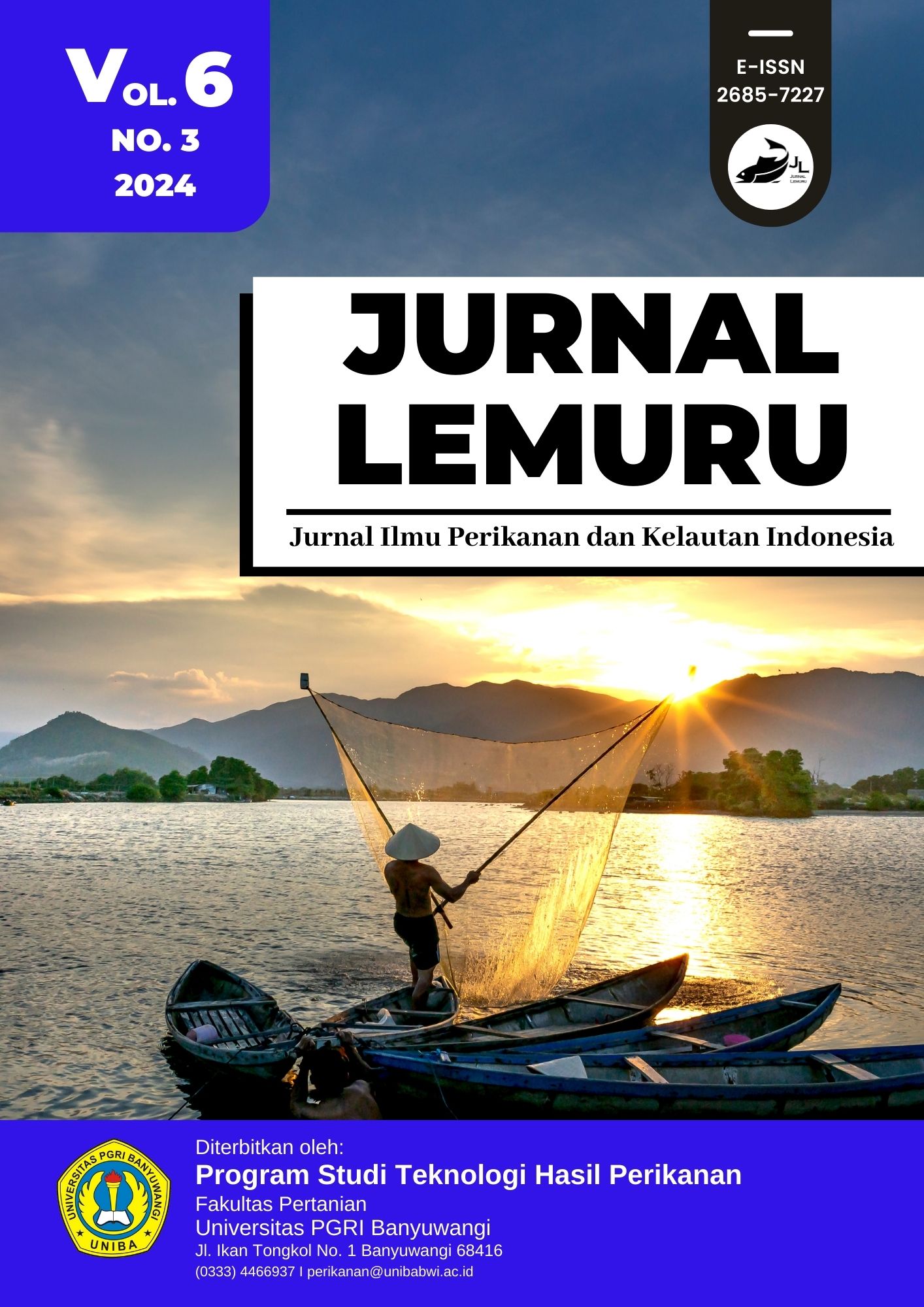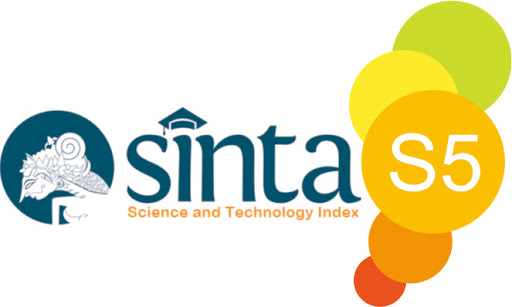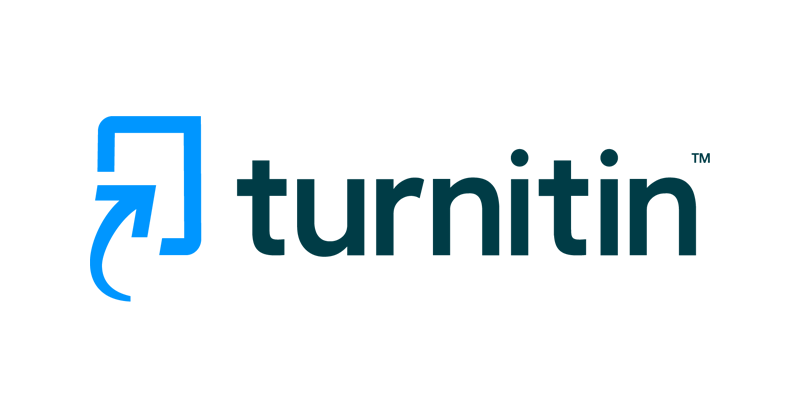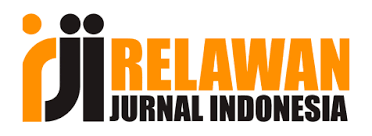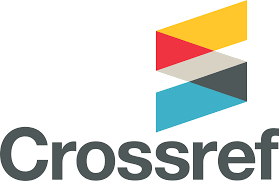KOMPOSISI DAN KEANEKARAGAMAN JENIS TERIPANG (HOLOTHUROIDEA) DI PERAIRAN PANTAI PASIR PUTIH PANGANDARAN JAWA BARAT
Keywords:
Composition, Diversity; sea cucumbers (Holothuroidea), PangandaranAbstract
Sea cucumbers are special marine resources that have high protein content and high economic value. Some of them are commercially important culture species in Asian countries. It is interesting to study, because the composition and diversity of sea cucumbers are influenced by the environment in which they live. The purpose of this study was to determine the composition and diversity of sea cucumbers (Holothuroidea) and water quality (salinity, temperature, dissolved oxygen and pH) suitable for the life of sea cucumbers (Holothuroidea) in the waters of Pasir Putih Beach Pangandaran, West Java. Sampling was conducted using line transect and quadrant transect methods, sea cucumber samples were collected by hand picking and then in-situ identified. The results showed that the highest species composition was Holothuria atra (29.62%), Stichopus sp. (25.93%), Holothuria scabra (18.52%), Synapta maculata (14.81%) and the lowest Holothuria marmorata. Sea cucumber diversity was categorised as low (H‘: 1.27-1.36) and the highest species diversity was Holothuria atra (H’: 1.06). The water quality at Pasir Putih Beach Pangandaran is quite good for sea cucumber (Holothuridea) life, with water parameters such as temperature ranging from 30-30.3 °C, salinity 31-31.5 ppt, pH 7.5-8, and dissolved oxygen (DO) 5.5 mg/l.
References
Allen, G. R., & Steene, R. (2007). Indo-Pacific coral reef field guide: Most comprehensive of nature’s, exquisite masterpiece, The Living Coral Reef! (First published 1994). Tropical Reef Research.
Amijaya, D. H., & Sarju, W. (2008). Studi Sedimentologi Endapan Sedimen Di Pantai Pangandaran, Ciamis, Jawa Barat Setelah Tsunami. 109–112.
Bakus, G. J., Nishiyama, G., Hajdu, E., Mehta, H., Mohammad, M., Pinheiro, U. D. S., Sohn, S. A., Pham, T. K., Yasin, Z. B., Shau-Hwai, T., Karam, A., & Hanan, E. (2007). A comparison of some population density sampling techniques for biodiversity, conservation, and environmental impact studies. Biodiversity and Conservation, 16(9), 2445–2455. https://doi.org/10.1007/s10531-006-9141-7
Battaglene, S. C., Seymour, J. E., & Ramofafia, C. (1999). Survival and growth of cultured juvenile sea cucumbers, Holothuria scabra. Aquaculture, 178(3–4), 293–322. https://doi.org/10.1016/S0044-8486(99)00130-1
Bruckner, A. W. (2005). The recent status of sea cucumber fisheries in the continental United States of America. SPC Beche-de-Mer Information Bulletin, 22, 39–46.
Conand, C., & Muthiga, N. A. (2007). Commercial sea cucumbers: A review for the Western Indian Ocean. WIOMSA (Western Indian Ocean Marine Science Association). https://www.researchgate.net/publication/274834910_Commercial_sea_cucumbers_A_review_for_the_Western_Indian_Ocean
Dafni, J. (2008). Diversity and Recent Change In The Echinoderm Fauna Of The Gulf Of Aqaba With Emphasis On The Regular Echinoids. In The Improbable Gulf: Enviroment, Biodiversity and Preservation (pp. 226–234). Magnes Press.
Darsono, P., Notowinarto, & Widiastuti, E. (1996). Tinjauan tentang pengelolaan kualitas air laut pemeliharaan teripang pasir, Holothuria scabra Jaeger, di laboratorium. In Inventarisas dan Evaluasi Potensi Laut—Pesisir II, Geologi, Kimia, Biologi dan Ekologi (pp. 78–85). Puslitbang Oseanologi-LIPI.
Dissanayake, D. C. T., & Stefansson, G. (2012). Habitat preference of sea cucumbers: Holothuria atra and Holothuria edulis in the coastal waters of Sri Lanka. Journal of the Marine Biological Association of the United Kingdom, 92(3), 581–590. https://doi.org/10.1017/S0025315411000051
DKTNL. (2004). Pedoman Pengembangan Wisata Bahari Berbasis Masyarakat Di Kawasan Konservasi Laut. Direktorat Konservasi dan Taman Nasional Laut. Direktorat Jenderal Kelautan Pesisir dan Pulau-Pulau Kecil, Departemen Kelautan dan Perikanan.
Domínguez-Godino, J. A., & González-Wangüemert, M. (2020). Habitat associations and seasonal abundance patterns of the sea cucumber Holothuria arguinensis at Ria Formosa coastal lagoon (South Portugal). Aquatic Ecology, 54(1), 337–354. https://doi.org/10.1007/s10452-020-09746-0
Fahruddin, M., Suriyadin, A., Abdurachman, M. H., Murtawan, H., & Ilyas, A. P. (2022). Keanekaragaman Lamun Di Pesisir Bahoi, Sulawesi Utara. Jurnal LEMURU: Jurnal Ilmu Perikanan Dan Kelautan, 4(3), 159–165. https://doi.org/DOI: https://doi.org/10.36526/lemuru.v4i3.2282
Hamamoto, K., Poliseno, A., Soliman, T., & Reimer, J. D. (2022). Shallow epifaunal sea cucumber densities and their relationship with the benthic community in the Okinawa Islands. PeerJ, 10, e14181. https://doi.org/10.7717/peerj.14181
Hamel, J. F., & Mercier, A. (2008). Population Status, Fisheries and Trade of Sea Cucumbers in Temperate Areas of the Northern Hemisphere. In Sea Cucumbers. A Global Review of Fisheries and Trade (FAO Fisheries and Aquaculture Technical Paper, pp. 257–291). FAO. https://www.researchgate.net/publication/268746789_Population_status_fisheries_and_trade_of_sea_cucumbers_in_temperate_areas_of_the_Northern_Hemisphere
Hamel, J.-F., Conand, C., Pawson, D. L., & Mercier, A. (2001). The sea cucumber Holothuria scabra (Holothuroidea: Echinodermata): Its biology and exploitation as Beche-de-mer. In Advances in Marine Biology (Vol. 41, pp. 129–223). Elsevier. https://doi.org/10.1016/S0065-2881(01)41003-0
Hernawan, Reza, F., Fitriyana, & Fahrizal, W. (2023). Tingkat Kesejahteraan Pembudidaya Ikan Keramba Jaring Apung (KJA) Di Desa Embalut Kecamatan Tenggarong Seberangkabupaten Kutai Kartanegara. Jurnal LEMURU: Jurnal Ilmu Perikanan Dan Kelautan, 5(3), 410–422. https://doi.org/DOI: https://doi.org/10.36526/jl.v5i3.2897.
Hossain, A., Dave, D., & Shahidi, F. (2020). Northern Sea Cucumber (Cucumaria frondosa): A Potential Candidate for Functional Food, Nutraceutical, and Pharmaceutical Sector. Marine Drugs, 18(5), 274. https://doi.org/10.3390/md18050274.
Jafaar, B., Salapuddin, A., & Quilala, E. P. (2018). Abundance and Distribution of Sea Cucumber in Barangay Semut, Basilan Province, Philippines. The Official Research Journal Publication of Western Mindanao State University, 49–60.
Jontila, J. B. S., Balisco, R. A., & Batin, G. (2017). Species composition, density and distribution of sea cucumbers (Holothuroidea) at Arreceffi Island, Honda Bay, Palawan, Philippines. SPC Beche-de-Mer Information Bulletin, 37, 21–29.
Komala, R. (2015, April 1). Keanekaragaman teripang pada ekosistem lamun dan terumbu karang di Pulau Bira Besar, Kepulauan Seribu, Jakarta. Seminar Nasional Masyarakat Biodiversitas Indonesia. https://doi.org/10.13057/psnmbi/m010209.
Liu, H., Xue, C., & Li, Z. (2023). Diversity, Distribution, and Biology of Sea Cucumber. In C. Xue (Ed.), Advances in Sea Cucumber Processing Technology and Product Development (pp. 1–20). Springer International Publishing. https://doi.org/10.1007/978-3-031-16512-2_1.
Liu, S. (2020). Are Sea Cucumbers right for your tank. Coralsdaily. https://www.reef2reef.com/threads/are-sea-cucumbers-right-for-your-tank.762927/
Lovatelli, A. & FAO (Eds.). (2004). Advances in sea cucumber aquaculture and management. Food and Agriculture Organization of the United Nations.
Madyawan, D., Hendrawan, I. G., & Suteja, Y. (2020). Pemodelan Oksigen Terlarut (Dissolved Oxygen/DO) di Perairan Teluk Benoa. Journal of Marine and Aquatic Sciences, 6(2), 270. https://doi.org/10.24843/ jmas.2020.v06.i02.p15.
Martoyo, J., Aji, N., & Winanto, T. (2006). Budidaya Teripang (Cet. ke-5). Penebar Swadaya.
Mercier, A., Battaglene, S. C., & Hamel, J.-F. (1999). Daily burrowing cycle and feeding activity of juvenile sea cucumbers Holothuria scabra in response to environmental factors. Journal of Experimental Marine Biology and Ecology, 239(1), 125–156. https://doi.org/10.1016/S0022-0981(99)00034-9.
Mercier, A., Battaglene, S. C., & Hamel, J.-F. (2000). Periodic movement, recruitment and size-related distribution of the sea cucumber Holothuria scabra in Solomon Islands. Hydrobiologia, 440(1/3), 81–100. https://doi.org/ 10.1023/A:1004121818691.
Nurkhozin, A. A., Achmad, D. S., Syaia, N., Yasin, I. A., & Natsir, S. R. A. (2022). Prevalensi Viral Nervous Necrosis(Vnn) Pada Ikan Kerapu Ekor Bulan (Variola sp.) Di Perairan Gorontalo. Jurnal LEMURU: Jurnal Ilmu Perikanan Dan Kelautan, 4(3), 99–108. https://doi.org/10.36526/lemuru.v4i3.2295.
Odum, E. P. (1998). DASAR-DASAR EKOLOGI (3rd ed.). Gadjah Mada University Press.
Pangestuti, R., & Arifin, Z. (2018). Medicinal and health benefit effects of functional sea cucumbers. Journal of Traditional and Complementary Medicine, 8(3), 341–351. https://doi.org/10.1016/j.jtcme.2017.06.007.
Purcell, S. W., Conand, C., Uthicke, S., & Byrne, M. (Eds.). (2016). Ecological roles of exploited sea cucumbers. Oceanography and Marine Biology: An Annual Review (Vol. 54). CRC Press. https://doi.org/10.1201/9781315368597.
Purcell, S. W., Lovatelli, A., González-Wangüemert, M., Solís-Marín, F. A., Samyn, Y., & Conand, C. (2023). Commercially important sea cucumbers of the world (2nd ed.). FAO. https://doi.org/10.4060/cc5230en.
Purcell, S. W., Samyn, Y., & Conand, C. (2012). Commercially important sea cucumbers of the world. FAO Rome.
Setyastuti, A., Wirawati, I., Permadi, S., & Vimono, I. B. (2019). Teripang Indonesia: Jenis, Sebaran dan Stutus Nilai Ekonomi. P.T. Media Sains Nasional.
Sosiawan, T. G., & Mustalafin. (2022). Studi Kelimpahan dan Sebaran Jenis Teripang (Holothuria sp.) di Pulau Kelapa Dua, Pulau Panjang Besar dan Panjang Kecil, Kepulauan Seribu. Simposium Nasional IX Kelautan Dan Perikanan, 9, 15–24.
Sun, C., Huang, D., Xu, Q., Gao, F., Li, X., & Wang, A. (2022). Diverse habitat preferences of two sea cucumber species and the seasonal change in a coral reef area. Journal of Oceanology and Limnology, 40(4), 1578–1591. https://doi.org/10.1007/s00343-021-1254-z
Supono, & Arbi, U. Y. (2010). Struktur komunitas ekinodermata di padang lamun perairan kema, Sulawesi Utara (Vol. 36). P2O LIPI.
Toral-Granda, V., Lovatelli, A., & Vasconcellos, M. (2008). Sea cucumbers: A global review of fisheries and trade. FAO Rome.
Uthicke, S., & Benzie, J. (1999). Allozyme variation as a tool for beche-de-mer fisheries management: A study on Holothuria scabra (sandfish). SPC Beche-de-Mer Information Bulletin, 12, 18–23.
Wahyu, I. E. N., Prasita, V. D., & Pranowo, W. S. (2024). Karakter Oksigen (O₂) Terlarut di Perairan Selat Madura Tahun 2022: Characteristics of Dissolved Oxygen (O₂) in Madura Strait Coastal Waters in 2022. Jurnal Hidropilar, 10(1), 9–16. https://doi.org/10.37875/hidropilar.v10i1.331
Yusron, E. (2007). Sumberdaya teripang (Holothuroidea) di Perairan Pulau Moti, Maluku Utara. P2O LIPI.
Yusron, E. (2019). Sumberdaya Teripang (Holothuroidea) Di Kepulauan Sekotong, Nusa Tenggara Barat. Biota : Jurnal Ilmiah Ilmu-Ilmu Hayati, 59–64. https://doi.org/10.24002/biota.v8i2.2885.
Downloads
Published
How to Cite
Issue
Section
License
Copyright (c) 2024 Tjahjo Winanto, Any Kurniawati, Purwo Raharjo, Kasprijo, Nabela Fikriyya

This work is licensed under a Creative Commons Attribution-ShareAlike 4.0 International License.
Copyright (c) 2024
This work is licensed under a Creative Commons Attribution-ShareAlike 4.0 International License.

